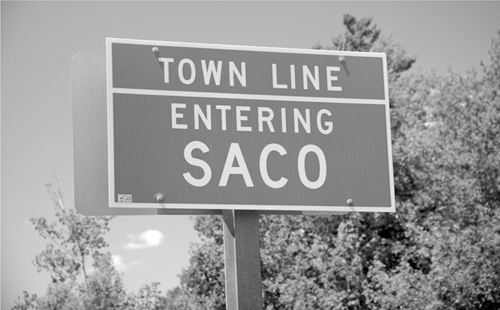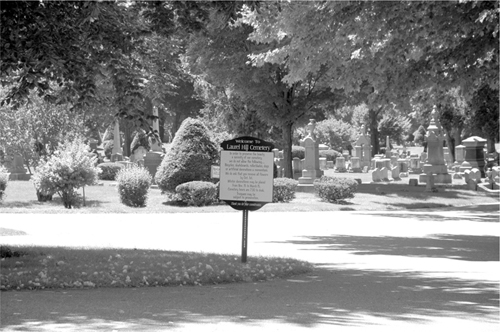
Arlene’s daughter, Mandy, and her fiancé, Justin, live in Biddeford, Maine. Saco is the adjoining town. The towns are so close together that there are some who refer to the area as Saco-Biddeford. Saco is a typical sleepy little eastern Maine town. It appears that once, while the residents slept, there were some who were reported to be roaming the night, sucking the life out of their loved ones.
In Dr. Michael Bell’s Food for the Dead, there is mention of a series of exorcisms that took place in Saco between 1847 and 1862. Although there are no specific names, there are references to this fact in a pamphlet by Dr. Henry Ingersoll Bowditch (1808–1892). Taking Mr. Bell’s lead, I decided to look up the writing myself. The pamphlet Consumption in New England: Or Locality One of Its Chief Causes: An Address Delivered before the Massachusetts Medical Society outlines vaguely the cases of consumption and their treatment.
Dr: Allen of Saco, Maine, than whom there lives no more intelligent witness—a practitioner of long standing—assures me that, in his own practice, for fifteen years past, he has noticed that on two ridges of land, whose only difference consists of this characteristic of moisture of the soil, almost every family has been decimated on the wet part, while almost all upon the dry portion have escaped.
He goes on to describe the surrounding area and then adds, “In fact, in former times, the superstitious frequently had their friends, who died of consumption, disinterred…”

Entering Saco, Maine, where exhumations for vampirism were once reported to have taken place.
Bowditch also explains, in depth, how the wet and damp locales of New England were rife with the dreaded disease. He cites statistical data to back up his theory that consumption was much more prevalent in these damp areas. He also had doctors and specialists from various places throughout New England back up his findings. He mentions that a Dr. Trafton of Kennebunkport, Maine, substantiated that consumption cases occurred in greater numbers near the port, where the soil and coastal exposure created damp conditions. Kennebunk, with its wooded land, higher elevation, drier climate and fewer open areas, was in contrast to the port region. Consumption was found in a much lesser degree in places where the climate was drier.
Bowditch, through his research and experiments, came to a few conclusions about the disease. One was that consumption was not equally distributed across the region. Another was that the amount of cases from one area to another depended on the soil near where the patients resided. He also concluded that the moisture within the soil gave rise to consumption.
Through his research and conclusions, Bowditch believed he better understood the causes, treatments and preventative measures pertaining to consumption. Many of his colleagues supported his belief. However, the disease still raged across the region regardless of terrain or climate. (An interesting note is that Bowditch was chairperson for the Massachusetts 1847-1862 State Board of Health, as well as president of the American Medical Association. He published a few writings on inductive reasoning in medicine and concepts of state and public health. His work would have been highly regarded by his peers.)
Arlene and I decided to take a trip up to Saco and see what we could find. The first place to look would be a cemetery. If most of these incidents took place in the fifteen-year period between 1847 and 1862, chances are, the deceased would have family plots in a garden cemetery. Garden cemeteries—large, landscaped burial grounds—became popular in the early nineteenth century. The first chartered burial ground in the United States is reported to be the Grove Street Burial Ground, established in New Haven, Connecticut, and incorporated in October 1797. It is also hailed as the first nonprofit private burial ground in the world. The planned layout, family-owned plots and carefully landscaped flora and trees were something no one really saw in this country until the Mount Auburn Cemetery opened in Cambridge in 1831.
Sure enough, Mandy and Justin knew where the only cemetery of such caliber was in Saco. We soon came upon the Laurel Hill Cemetery, a well-groomed, large burial ground with little bridges crossing a stream and twisting little lanes much akin to older cemeteries. Mandy’s four-wheel drive Tracker was perfect for the time of year, January, when the roads were barely plowed if at all. We snaked through the cemetery, sometimes ramming through the snow banks left behind by the plows. Our main goal was to find stones and plots from that period (1847–1862) of family members who may have died in close succession. A subsequent visit in July enabled us to explore further, as the roads were clear. Sure enough, there were plots where the dates on the stones were from the same year or very close. While this, of course, is not proof that consumption was the cause or that these were the families Dr. Bowditch referred to in his paper, it certainly points to that possibility.

Laurel Hill Cemetery in Saco, Maine. There are several plots in this cemetery of family members who died very close together.
The actual names of the families about whom Dr. Bowditch and Dr. Allen speak remain a matter of conjecture. With no actual writing in stone, it is hard to tell if consumption was the actual cause of death or if these people were claimed by one of the many other diseases that plagued New England during the time.